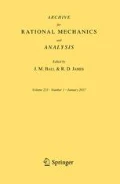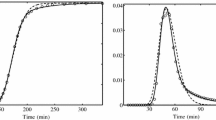Abstract
Multiphase mechanical models are now commonly used to describe living tissues including tumour growth. The specific model we study here consists of two equations of mixed parabolic and hyperbolic type which extend the standard compressible porous medium equation, including cross-reaction terms. We study the incompressible limit, when the pressure becomes stiff, which generates a free boundary problem. We establish the complementarity relation and also a phase-segregation result. Several major mathematical difficulties arise in the two species case. Firstly, the system structure makes comparison principles fail. Secondly, segregation and internal layers limit the regularity available on some quantities to BV. Thirdly, the Aronson–Bénilan estimates cannot be established in our context. We are led, as it is classical, to add correction terms. This procedure requires technical manipulations based on BV estimates only valid in one space dimension. Another novelty is to establish an \(L^1\) version in place of the standard upper bound.


Similar content being viewed by others
References
Aronson, D.G., Bénilan, P.: Régularité des solutions de l’équation des milieux poreux dans \({\mathbb{R}}^n\). CR Acad. Sci. Paris Sér. AB288(2), A103–A105, 1979
Bertsch, M., Dal Passo, R., Mimura, M.: A free boundary problem arising in a simplified tumour growth model of contact inhibition. Interfaces Free Bound. 12(2), 235–250, 2010
Bertsch, M., Gurtin, M.E., Hilhorst, D.: On interacting populations that disperse to avoid crowding: the case of equal dispersal velocities. Nonlinear Anal. Theory Methods Appl. 11(4), 493–499, 1987
Bertsch, M., Hilhorst, D., Izuhara, H., Mimura, M.: A nonlinear parabolic–hyperbolic system for contact inhibition of cell-growth. Differ. Equ. Appl. 4(1), 137–157, 2012
Bresch, D., Colin, T., Grenier, E., Ribba, B., Saut, O.: Computational modeling of solid tumor growth: the avascular stage. SIAM J. Sci. Comput. 32(4), 2321–2344, 2010
Bris, C.L., Lions, P.-L.: Existence and uniqueness of solutions to Fokker–Planck type equations with irregular coefficients. Commun. Partial Differ. Equ. 33(7), 1272–1317, 2008
Busenberg, S.N., Travis, C.C.: Epidemic models with spatial spread due to population migration. J. Math. Biol. 16(2), 181–198, 1983
Byrne, H.M., Drasdo, D.: Individual-based and continuum models of growing cell populations: a comparison. Math. Med. Biol. 58(4–5), 657–687, 2003
Carrillo, J.A., Fagioli, S., Santambrogio, F., Schmidtchen, M.: Splitting schemes and segregation in reaction cross-diffusion systems. SIAM J. Math. Anal. 50(5), 5695–5718, 2018
Craig, K., Kim, I., Yao, Y.: Congested aggregation via Newtonian interaction. Arch. Ration. Mech. Anal. 227(1), 1–67, 2018
Dambrine, J., Meunier, N., Maury, B., Roudneff-Chupin, A.: A congestion model for cell migration. Commun. Pure Appl. Anal. 11(1), 243–260, 2012
Degond, P., Hecht, S., Vauchelet, N.: Incompressible limit of a continuum model of tissue growth for two cell populations. arXiv:1809.05442, 2018
Gurtin, M.E., Pipkin, A.C.: A note on interacting populations that disperse to avoid crowding. Quart. Appl. Math. 42, 87–94, 1984
Gwiazda, P., Perthame, B., Świerczewska-Gwiazda, A.: A two species hyperbolic–parabolic model of tissue growth. arXiv:1809.01867, 2018
Hecht, S., Vauchelet, N.: Incompressible limit of a mechanical model for tissue growth with non-overlapping constraint. Commun. Math. Sci. 15(7), 1913, 2017
Kim, I., Požár, N.: Porous medium equation to Hele–Shaw flow with general initial density. Trans. Am. Math. Soc. 370(2), 873–909, 2018
Kim, I., Turanova, O.: Uniform convergence for the incompressible limit of a tumor growth model. Ann. Inst. H. Poincaré Anal. Non Linéaire35(5), 1321–1354, 2018
Kim, I.C., Perthame, B., Souganidis, P.E.: Free boundary problems for tumor growth: a viscosity solutions approach. Nonlinear Anal. 138, 207–228, 2016
Lorenzi, T., Lorz, A., Perthame, B.: On interfaces between cell populations with different mobilities. Kinet. Relat. Models10(1), 299–311, 2017
Lowengrub, J.S., Frieboes, H.B., Jin, F., Chuang, Y.-L., Li, X., Macklin, P., Wise, S.M., Cristini, V.: Nonlinear modelling of cancer: bridging the gap between cells and tumours. Nonlinearity23(1), R1–R91, 2010
Lu, P., Ni, L., Vázquez, J.-L., Villani, C.: Local Aronson–Bénilan estimates and entropy formulae for porous medium and fast diffusion equations on manifolds. J. Math. Pures Appl. (9)91(1), 1–19, 2009
Maury, B., Roudneff-Chupin, A., Santambrogio, F.: A macroscopic crowd motion model of gradient flow type. Math. Models Methods Appl. Sci. 20(10), 1787–1821, 2010
Maury, B., Roudneff-Chupin, A., Santambrogio, F.: Congestion-driven dendritic growth. Discrete Contin. Dyn. Syst. 34(4), 1575–1604, 2014
Maury, B., Roudneff-Chupin, A., Santambrogio, F., Venel, J.: Handling congestion in crowd motion modeling. Netw. Heterog. Media6(3), 485–519, 2011
Mellet, A., Perthame, B., Quirós, F.: A Hele–Shaw problem for tumor growth. J. Funct. Anal. 273(10), 3061–3093, 2017
Mészáros, A.R., Santambrogio, F.: Advection–diffusion equations with densityconstraints. Anal. PDE9(3), 615–644, 2016
Motsch, S., Peurichard, D.: From short-range repulsion to Hele–Shaw problem in a model of tumor growth. J. Math. Biol. 76(1–2), 205–234, 2018
Perthame, B., Quirós, F., Tang, M., Vauchelet, N.: Derivation of a Hele–Shaw type system from a cell model with active motion. Interfaces Free Bound. 16, 489–508, 2014
Perthame, B., Quirós, F., Vázquez, J.L.: The Hele–Shaw asymptotics for mechanical models of tumor growth. Arch. Ration. Mech. Anal. 212(1), 93–127, 2014
Preziosi, L.: A review of mathematical models for the formation of vascular networks. J. Theor. Biol. 333, 174–209, 2012
Ranft, J., Basana, M., Elgeti, J., Joanny, J.-F., Prost, J., Jülicher, F.: Fluidization of tissues by cell division and apoptosis. Natl. Acad. Sci. USA49, 657–687, 2010
Roose, T., Chapman, S.J., Maini, P.K.: Mathematical models of avascular tumour growth: a review. SIAM Rev. 49(2), 179–208, 2007
Vázquez, J.L.: The Porous Medium Equation: Mathematical Theory. Oxford University Press, Oxford 2007
Acknowledgements
F.B. and B.P. have received funding from the European Research Council (ERC) under the European Union’s Horizon 2020 research and innovation program (Grant Agreement No. 740623). M.S. acknowledges the kind invitation to LJLL funded by the previous grant. Furthermore, M.S. received funding for two research visits from the Doris Chen Mobility Award awarded by Imperial College London. C.P. acknowledges support from the Swedish Foundation of Strategic Research Grant AM13-004.
Author information
Authors and Affiliations
Corresponding author
Additional information
Communicated by P.-L. Lions
Publisher's Note
Springer Nature remains neutral with regard to jurisdictional claims in published maps and institutional affiliations.
Appendix A. Energy
Appendix A. Energy
Proposition 5
Let \(H_1(p) := \int _0^{p} F(z) \, \mathrm {d}z\) and \(H_2(p) := \int _0^{p} G(z) \, \mathrm {d}z\) for \(p \geqq 0\). Then, the energy
is such that, for a constant C independent of \(\gamma \) and \(\varepsilon \),
Proof
Consider the equation for the pressure (16) and multiply by \(- \tfrac{\partial ^2 p_\gamma }{\partial x^2}\). Integration by parts yields
Moreover, using the equations for \(c_\gamma ^{(1)}\) and \(c_\gamma ^{(2)}\), we compute
and
Summing (45), (46) and (47), and using the uniform bounds for \(c_\gamma ^{(1)}\), \(c_\gamma ^{(2)}\) and the reaction terms, we get
Theorem 3.1, together with the Hölder inequality and the Sobolev embeddings, yield the desired bound (44). \(\quad \square \)
Rights and permissions
About this article
Cite this article
Bubba, F., Perthame, B., Pouchol, C. et al. Hele–Shaw Limit for a System of Two Reaction-(Cross-)Diffusion Equations for Living Tissues. Arch Rational Mech Anal 236, 735–766 (2020). https://doi.org/10.1007/s00205-019-01479-1
Received:
Accepted:
Published:
Issue Date:
DOI: https://doi.org/10.1007/s00205-019-01479-1




